Some mornings, it takes me a moment to remember where I am. It’s a hazard that comes with full-time travel, where every few days I’m in a different city, a different hostel, sometimes even a different country. But after a few moments, the cobwebs dissipate and I’m clear-headed. In Skopje, Macedonia, however, I had a constant feeling of déjà vu.
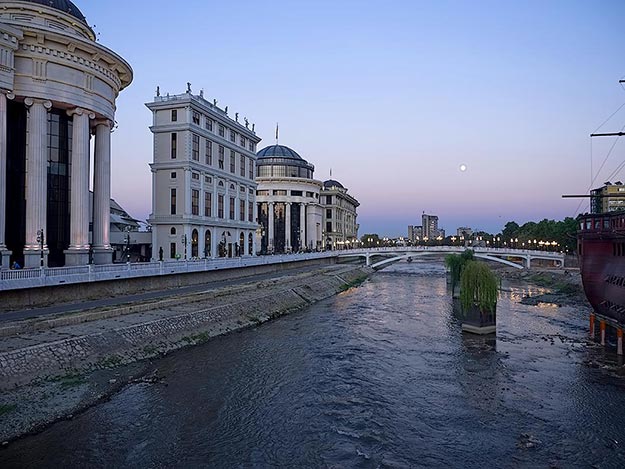
My list of things to do in Skopje began on the banks of the Vardar River. Here, a string of government buildings have been constructed of glistening white marble in neo-classic Roman style, right down to their Corinthian-capped columns. Two bridges over the river, the Art Bridge and the Bridge of Macedonian Civilizations, strongly resemble the Charles Bridge in Prague. On the main pedestrian avenue, a giant brass bull sits in front of a shoe shop rather than a stock exchange. A block away, the Porta Macedonia Arch is strikingly similar to the Arc de Triomphe in Paris.
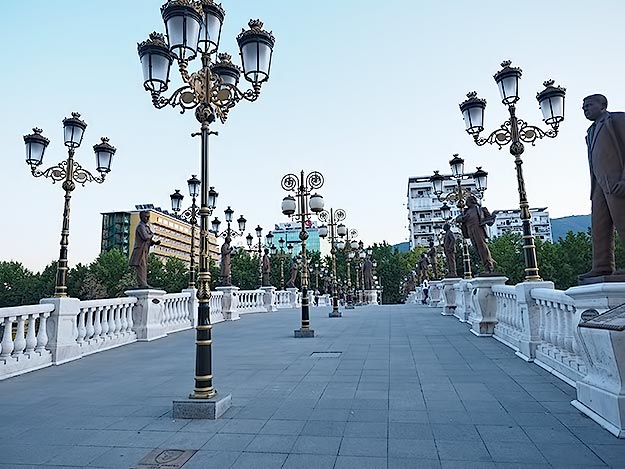
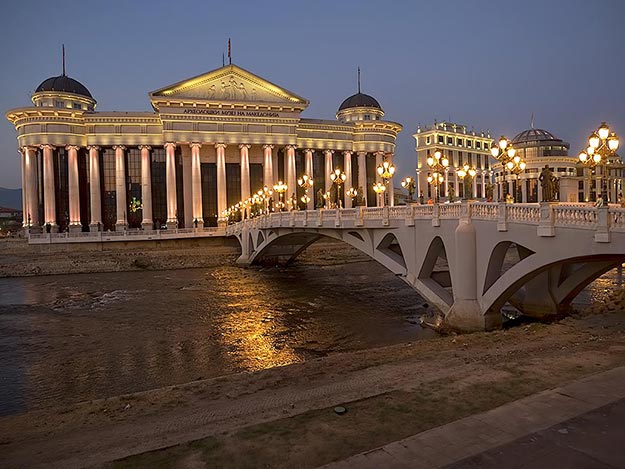
Dubbed the Skopje 2014 project, construction of these monuments was an attempt to add charm to the city center, which was hurriedly and unattractively reconstructed after the earthquake of 1963 leveled 80% of the city. Prime Minister Nikola Gruevski has publicly stated that Skopje 2014 was his idea. The millions of Euros spent on the project so far have been borrowed from commercial sources that include the International Monetary Fund and the World Bank. Many Macedonians I met wryly remarked that Gruevski has mortgaged the futures of their children and grandchildren. The potential 500 million Euros required to compete the project amounts to a whopping 22 percent of Macedonia’s GDP!


When I began to ask why, if Skopje 2014 was so unpopular, Macedonians have allowed the project to move forward with so little resistance, I discovered the “rest of the story.” Though publicly, government officials have touted the project as “if they build it, tourists will come,” many of the kitschy monuments are also deeply symbolic of a political rift between Macedonia and Greece. When Macedonia declared independence from the former Yugloslavia in 1991, they named their new country the Republic of Macedonia. Immediately, Greece balked, insisting that Macedonia was attempting to usurp its historical and cultural identity.

As with most European countries, the boundaries of Macedonia have changed significantly over time. The ancient kingdom of Macedonia lay almost entirely within the borders of what is today the Greek province of Macedonia, however under Philip II and, subsequently, his son, Alexander the Great, Macedonia expanded to include parts of Bulgaria, Albania, Serbia, and Kosovo. By the time Macedonia reached its present configuration, it included virtually none of the territory of Greek Macedonia, thus Greece’s insistence that it had no right to use the name.
Fearing that the chosen name signaled a desire on the part of Macedonians to recover their lost Greek territory, millions of Greek citizens took to the streets to protest. The Greek government subsequently filed a formal petition with the United Nations, objecting to any use of the name Macedonia. The United Nations recommended recognition of the country under the temporary name The Former Yugoslav Republic of Macedonia (FYROM). Though the country would continue to use Republic of Macedonia as its constitutional name, FYROM would be used at the UN until settlement could be reached between Macedonia and Greece.
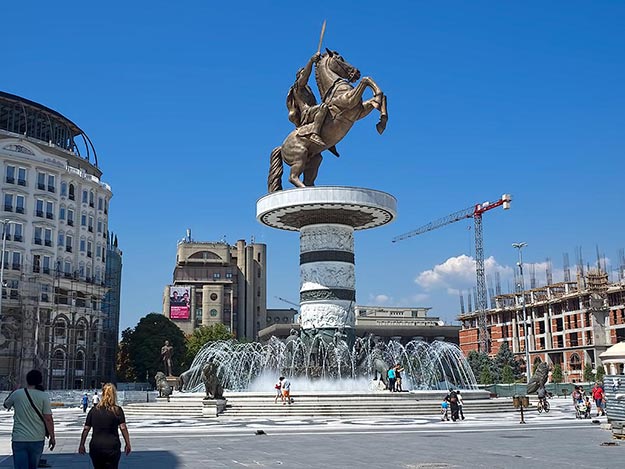
Negotiations continued. Macedonians considered the FYROM name to be humiliating, as it contains Yugoslavia, the country that usurped its independence. They continued to refer to the country as the Republic of Macedonia wherever possible. Indeed, many UN members, including the U.S, China, and Russia, recognized it under its preferred name. The issue was finally settled in late 2018 when both the Macedonian and Greek parliaments ratified the Prespa agreement, which called for the name of the country to be changed from Macedonia to North Macedonia.
The name change became official in February 2019, however debate rages on. Greece’s Ministry of Foreign Affairs continues to insist that Macedonia is attempting to steal Greece’s national heritage through “the raising of statues of Alexander the Great and Philip II…(and) construction of the Porta Macedonia arch, the surface of which bears carved reliefs depicting scenes from ancient Greek history.” In response, Macedonia has renamed the enormous sculpture of Alexander the Great to “Warrior on a Horse.” The bizarre situation is not entirely without humor. When the city renamed its new Skopje City Stadium the “National Arena Philip II of Macedonia” social media pundits mockingly began referring to it as “The Father of the Warrior on a Horse.”

Meanwhile, more monuments are in the works. On a free walking tour of Skopje, I learned that a recreation of Rome’s Spanish Steps will soon rise on the site of Mother Teresa’s childhood home. Next to the Porta Macedonia, a high rise is currently being wrapped with a new facade that will earn it the title of the highest neoclassical building in the world. On the shores of the Vardar River, which appears to be barely navigable by a rowboat, three behemoth Spanish Galleons are rising; they will soon house cafes, restaurants, and a hotel.
While not on any official list of things to do in Skopje, most tours stop to view three weeping willow trees planted in boxes in the middle of the river. One looks relatively healthy, but it is obvious the other two are struggling to survive. “These are the most expensive weeping willows ever bought,” our tour guide blurted. “Our Prime Minister imported them from New Zealand at a cost of $250,000 each. The one in the middle died so we had it replanted without telling him. We weren’t worried he would be angry the tree died…we were just afraid he would spend another quarter million to bring another one from New Zealand.”
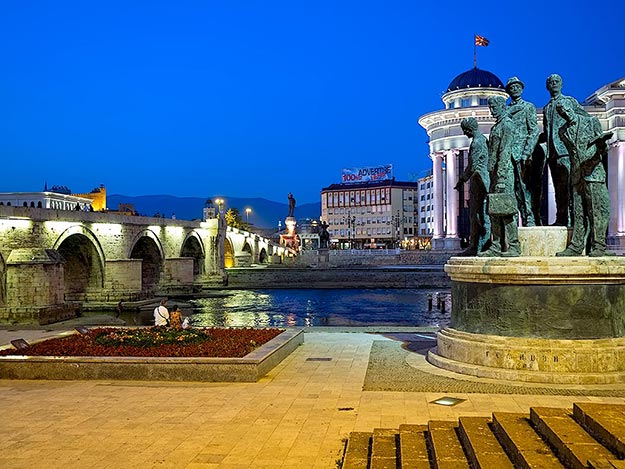


Putting politics (and insanity) aside, I must admit that the riverfront is beautiful, and the city does offer some authentic historical sights, including the Ottoman Old Bazaar and Hammam; the hilltop Kale Fortress, which protected the city for centuries against scores of invasions; an old stone Feudal Tower with Moorish wooden balconies; and the lovely 15th century Stone Bridge that connects the old city with the new. So do visit to Skopje if you plan to be in the Balkans. Just be prepared to feel a little…umm…disoriented.

Fascinating history, I wondered why I was seeing it referred to in places as “FYROM”! I’ve been working my way through your articles on Eastern European countries as we plan our three month trip and just wanted to say thanks for the great content 🙂
Caitlin, thanks so much for taking time to leave a comment. So happy you found my stories helpful.
Guys, the thing is that the Slavic speaking citizens of FYROM are Bulgarians who have been brainwashed and de-Bulgarised by their former Serb occupyers who occupied the area since 1912, they failed to make them \”Serbs\” directly but as a half winning result inflicted in their brains a\”Macedonian\” identity… The present day FYROM governement went much deeper into this and claims crazily an ancient origin of its slavic people, hence disturbing deeply Bulgaria and Greece!!!
The article fails to point out the obvious. The Majority of population in Macedonia (region) are Greeks since Antiquity and they rightfully call themselves Macedonians. Ancient Macedonians one way or another identified themselves as Greeks.
The modern inhabitants of the country Macedonia are mostly of Slavic background thus totally unrelated to the ancient ones. Lines like “Fearing that the chosen name signaled a desire on the part of Macedonians to recover their lost Greek territory” make no sense as the modern ethnic Macedonians have nothing to do with the ancient ones.
Ancient Macedonians never identified with Greeks, due to the fact that there was no Greek nation than, only Athinanians, Spartans, Thebans etc. Macedonia was a nation a kingdom, greece was a complot of cities often in war with each other.
I believe that you will agree that the region of northern Greece is Macedonia. Never the less you are quiet eloquent and you seem like a educated person. One thing is to dig in the ancient history in the search for the truth and another to say that the majority of population in Macedonia region is Greek. Well, at least that one its easy to be checked no need to open any books. Let me get straight to the point, no hard feelings, and no hand wrestling, or passionate conversations. All that northern Greece, start from Castoria and upwards are, if not more, at least 90% populated with Slavic population. Ill say again no need for argument or proving any fact to each other. I just feel sorry for you who are not aware who lives in your country.
Your comment fails to mention that Greece as a country was invented by Bavarian King Otto in 1832 after the region was liberated from the Ottoman Empire.
You also fail to mention that Macedonia was partitioned in 1913 with Greece occupying 51%.
Macedonians were never Greek throughout history. Try reading a book, Rick.
Samuel: Your comment is fine…up to the last sentence, which is demeaning and rude. This is the problem with the world today; we have lost the ability to talk to one another civilly and to respect each others’ opinions. Should you care to comment again, leave off the hateful parts.
Barbara, what a nonsens you wtote in this article…
Not nonsense Pjuk. If you have issue with what I stated, maybe you should speak to the companies doing the walking tours, who provided the information. Better yet, go there and see for yourself what I’m talking about.
Thumbs up Barbara, objective, thorough and non biased article. Thank you.
What a kind thing to say, John. Thank you very much.
barbara, could you please give me information which companies doing the walking tours have you been contacting?
Sorry Iskra, but I don’t have that specific information. Best to just Google it to get current info.